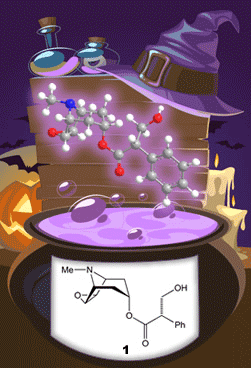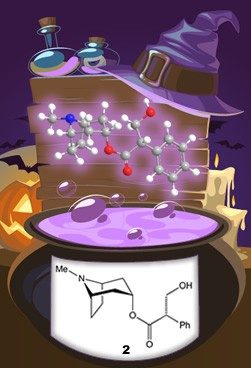
Scopolamine (1) and its biochemical precursor hyoscyamine (2) are deadly-nightshade alkaloids that are also found other plants of the Solanaceae family such as mandrake, jimsonweed, and tomato. Hyoscyamine is the enantiomer of the well-known nightshade alkaloid atropine.
Both alkaloids are extremely poisonous and have hallucinogenic effects. (Mandrake is sometimes called “insane root”.) They are anticholinergics, and, when used in small doses, they have medical uses such as treating gastrointestinal disorders. Plant extracts containing them have been used medicinally and ritually since biblical times or earlier.
Scopolamine is used criminally to poison people, not only to murder them but also to make them vulnerable to robbery or rape. Despite its adverse effects, it also has been tried as a “truth drug”.
MOTW update: September 14, 2020
Scopolamine and its biochemical precursor hyoscyamine are both highly toxic and hallucinogenic. They are found in plants of the Solanaceae family such as deadly nightshade, mandrake, jimsonweed, and—surprisingly—tomato. Despite their hazardous nature, both alkaloids are used in medicine. Recently, Christina D. Smolke* and Prashanth Srinivasan at Stanford University (CA) engineered Saccharomyces cerevisiae (brewer’s yeast) to produce hyoscyamine and scopolamine. The biosynthetic pathway is considered to be the longest and most complex to date for engineered yeast.

Learn more about this molecule from CAS, the most authoritative and comprehensive source for chemical information.
Molecule of the Week needs your suggestions!
If your favorite molecule is not in our archive, please send us a message. The molecule can be notable for its current or historical importance or for any quirky reason. Thank you!
Stay Ahead of the Chemistry Curve
Learn how ACS can help you stay ahead in the world of chemistry.


